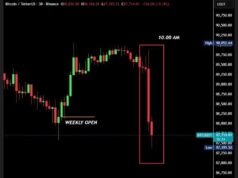Despite recent market turbulence, Bitcoin‘s underlying strength is showing bullish signals, with its “money vessel” swelling to a robust $8 billion. This surge in on-chain activity suggests that even as ETF inflows lag and investor sentiment wavers, fundamental demand for BTC remains surprisingly resilient. The central question now becomes: is this a temporary blip or the foundation for a sustained rally?
The realized cap of Bitcoin, a metric reflecting the dollar value of all coins at their last moved price, has surpassed $1.1 trillion, indicating a significant accumulation of wealth within the network. This increase suggests fresh capital entering the Bitcoin ecosystem, despite prevailing anxieties.
Ki Young Ju, the founder and CEO of CryptoQuant, attributes these inflows primarily to Bitcoin treasury firms and exchange-traded funds (ETFs). These entities, often viewed as institutional players, are demonstrably increasing their Bitcoin holdings, reinforcing its status as a legitimate asset class.
However, Ju cautions that a full-fledged price recovery hinges on the resurgence of large-scale acquisitions by Bitcoin ETFs and Michael Saylor’s Strategy. Without these heavy hitters consistently buying, the market’s upward momentum could remain constrained.
“Demand is now driven mostly both slowing buys recently. If these two channels recover, market momentum likely returns.”
This perspective highlights the delicate balance between organic demand and the influence of major institutional actors in shaping Bitcoin’s price trajectory.
Mining Operations Expand
Beyond institutional accumulation, Bitcoin miners are actively expanding their operations, leading to a rising hashrate. This increase in computational power dedicated to securing the network is often viewed as a strong, long-term bullish signal.
As Ju aptly puts it, this expansion signifies the continued growth of the “Bitcoin money vessel,” suggesting that the underlying infrastructure supporting the cryptocurrency is strengthening.
For example, American Bitcoin, a mining firm linked to the Trump family, recently invested a substantial $314 million to acquire 17,280 application-specific integrated circuits (ASICs), underscoring their confidence in the future of Bitcoin mining.
Despite the positive on-chain signals, investor sentiment remains fragile, struggling to shake off the lingering effects of a significant $19 billion market crash earlier this month. This disconnect between fundamentals and sentiment highlights the inherent volatility of the crypto market and the psychological factors that can influence price action.
However, analysts at Bitfinex exchange offer a more optimistic outlook, suggesting that a resurgence in ETF inflows and potential monetary easing by the Federal Reserve could propel Bitcoin’s price to a staggering $140,000 in November.
“Our base case sees Bitcoin rising towards $140,000, with total ETF inflows between $10 and $15 billion not being surprising.”
They identify potential catalysts such as Federal Reserve easing policies, increased ETF inflows, and historical Q4 strength, while acknowledging the risks posed by tariffs and geopolitical uncertainties.
Ultimately, Bitcoin’s future trajectory will depend on a complex interplay of factors, including institutional adoption, regulatory developments, and macroeconomic conditions. While the recent on-chain activity provides a glimmer of hope, the path to sustained recovery remains fraught with challenges. The digital asset’s journey continues, marked by both promise and peril.





